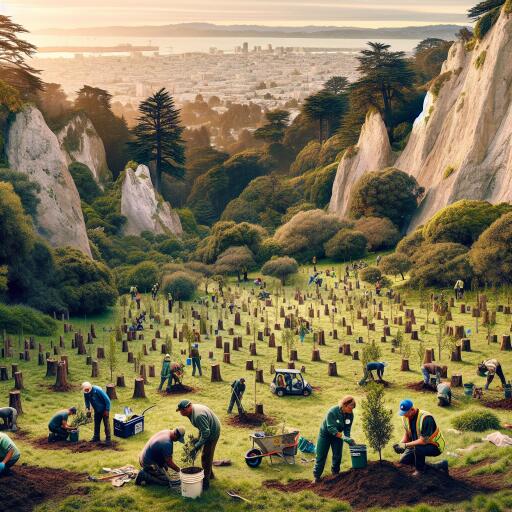
Berkeley Initiates Green Transformation with Native Tree Plantings at Indian Rock Park
Indian Rock Park, a cherished natural haven in Berkeley, is poised to witness a significant ecological transformation. Following the removal of several deteriorating blue gum eucalyptus trees, California’s native greenery is set to reclaim its space. The forthcoming winter is anticipated to bring the planting of native saplings, including the resilient manzanitas, majestic coast live oaks, and the distinctive California buckeye, marking a pivotal step towards revitalizing the park’s ecosystem.
The removal of the last eucalyptus trees in April was part of a broader ecological strategy to bolster Berkeley’s urban forest, focusing on enhancing biodiversity through native plantings. Over 20 native shrubs and young trees have already found a new home in the park, enriching the landscape with varieties such as manzanita, western redbud, and California flannelbush, according to Berkeley’s urban forestry experts.
These efforts are but a chapter in a larger story of ecological enhancement across Berkeley. In the initial months of 2024 alone, over 700 trees were planted across the city’s parks and streets, signifying a collective endeavor towards an expansive and diverse urban canopy. A substantial portion of these plantings was achieved with the help of community volunteers, particularly around the Aquatic Park area.
Yet, this green revival isn’t without its hurdles. The newly planted saplings face threats from deer and the limitations of the city’s current irrigation infrastructure. Additionally, the changing climate poses challenges to selecting species that will thrive in the altered conditions of the East Bay, requiring a thoughtful approach to urban forestry that considers future survivability.
Addressing the unique challenges of urban greening in Berkeley, city officials are keen on selecting varieties that are not just native, but also suited to the urban environment. Pests, disease, and human interaction pose ongoing challenges to the young trees. To combat these, the city is implementing protective measures, including deer cages, and fostering care through a meticulous schedule of watering and maintenance.
Amid these efforts, the significance of native species to local biodiversity and ecosystem health is driving a shift in urban landscaping practices. The selection of plant species is crucial, with the aim of fostering ecosystems where plants can thrive and support local wildlife, including pollinators and birds. However, the realities of climate change necessitate the selection of varieties capable of withstanding hotter summers and emerging pests and diseases, including navigating the impact of invasive species such as the emerald ash borer.
This renewed focus on urban forestry represents a shift towards recognizing trees as imperative to climate resilience, public health, and social equity. With significant grants supporting the city’s mission, Berkeley is on a path to rectify historical disparities in tree canopy coverage, particularly in areas affected by redlining. The strategic planting of 600 drought-tolerant trees in underserved communities underscores a commitment to tree equity, improving access to green spaces for all city residents.
The creation of a dedicated tree planting unit underscores Berkeley’s investment in a greener future. Tasked with planting thousands of trees, this team is foundational to the city’s “Trees Make Life Better” initiative, aiming not just for quantity but ensuring the survival and thriving of new plantings. As the city advances with its greening efforts, the anticipation for a more biodiverse and resilient urban forest grows, promising a leafier, healthier Berkeley for generations to come.
In the face of environmental challenges, Berkeley’s proactive approach to expanding its tree canopy and embracing native species offers a blueprint for urban sustainability and biodiversity conservation. As Indian Rock Park begins its transformation, it symbolizes a broader commitment to nurturing spaces where community, nature, and wildlife thrive in harmony.





Leave a Reply